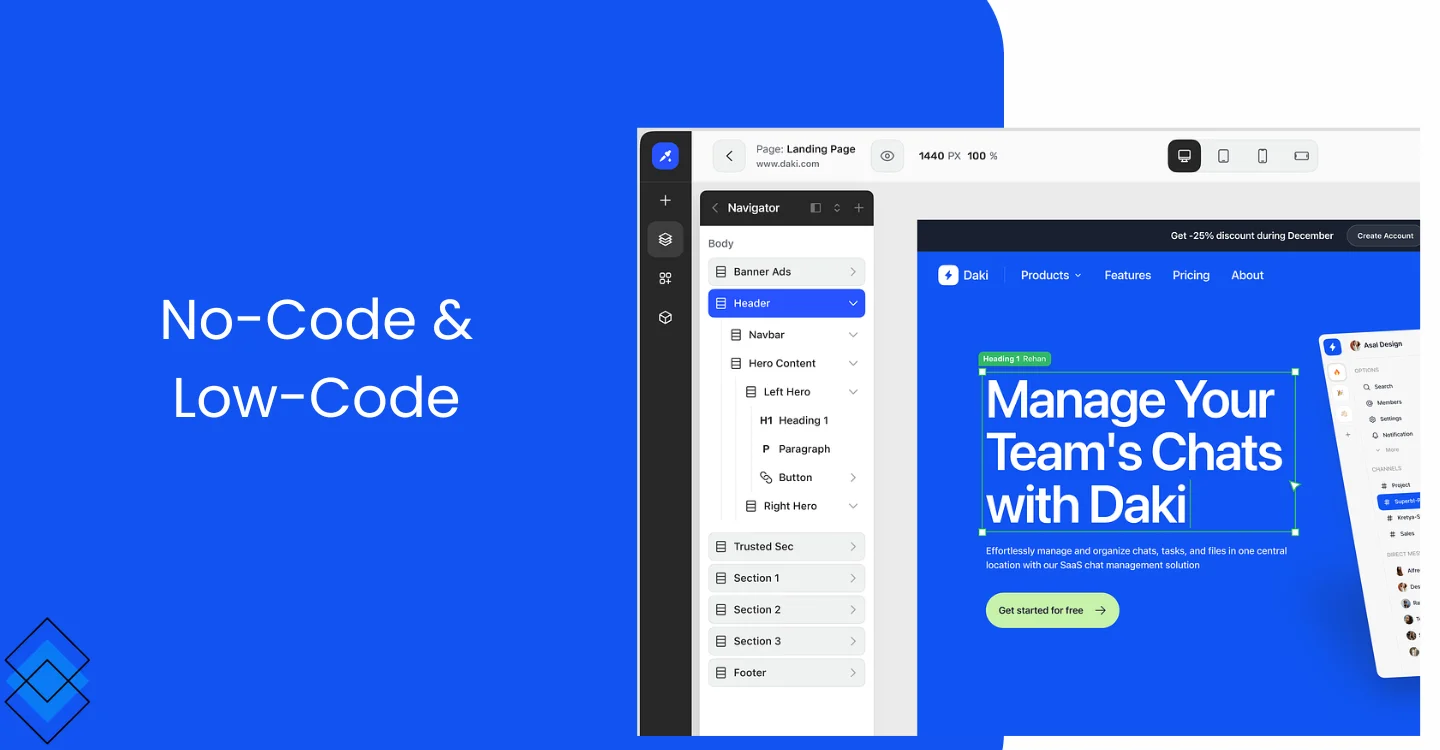No-code development is the process of creating a software application without the use of traditional coding or programming. This approach involves minimal or no code usage, relying instead on visual interfaces, drag-and-drop functions, and pre-built components to develop software.
In the no-code development procedure, users can assemble application elements and define their behavior through configuration rather than coding. These elements can include user interface elements, integration with external services, database connections, and business logic.
Low Code, also known as No Code, represents a rapidly evolving trend in business software products. This approach enables a shift in software development from the hands of developers to those of business owners. Essentially, it encompasses a variety of tools that empower non-technical individuals to create custom applications or apps for their businesses.
If you develop a software application using low-code or no-code platforms, it takes less time than traditional coding. This option becomes ideal for those who need a website for their business but lack the budget to cover the expenses of custom development and programming.
What are the Low Code/No-Code Features?
Low-code development provides a tool that eliminates the need for coding and allows the creation of entire applications. It automates the long-hand coding procedures and permits developers to concentrate on the substantial elements of the process.
Developers design low-code/no-code platforms with the following functionality and features:
- Visual design tools: No code encompasses prebuilt functions and components that allow you to drag and drop them onto your application, eliminating the need for coding.
- Connectivity: The program integrates with backend systems, such as ERPs or CRMs, to provide real-time data for reports or dashboards.
- Business rules: Business rules in connectivity require coding or configuration to implement the logic necessary for workflows and processes within an application.
- Business process automation: Business process automation: This feature enables developers to integrate applications with the existing business process through connectors or APIs, accessing the current system directly or connecting to it.
- Cloud deployment: Organizations can deploy applications in the cloud for testing purposes or in production environments, making them accessible to anyone with internet access.
Reasons Why No-Code, Low-Code Platform Adoption is Taking Off
Faster App Development
Businesses are looking for finding ways to cater to the application and fulfil the internal and external needs of the customer. Using the traditional application development process requires you to IT with your problem and ask for an application that can tackle it. This procedure often consumes a lengthy development loop due to the IT department juggling these requests with aligning their day-to-day task along with projects they are working on prior. Misinterpreting needs or the need for further process improvements can extend the development time, causing the procedure to accumulate more hours during the development cycle.
Addressing the Increasing Demand for Enterprise Apps
According to Gartner, the demand for applications is gradually increasing day by day, and the IT industry finds it difficult to meet this demand. The demand for app development will be at least 5x faster than the capacity of IT to cater to it. Through a no-code way of development, the rapidly growing demand for software development can be satisfied. No-code citizen app development frees up the headspace of designers or developers to concentrate on crucial matters
Reduced Dependency on IT Resources
Typical work standards demand reliance on IT at every stage of application development. The designers determined that it was all about the application, and the team embraced it. Cloud and no-code programming have flipped the model and reduced dependence on IT. Now, anyone can become a creator!
IT infrastructure and support are expensive; most small businesses and enterprises cannot afford them. Cloud-based no-code programming is the ideal solution. Additionally, this reduces the burden on developers, allowing them to focus on the company’s more complex, operations-driven tasks.
Embracing the Need for Agility
Businesses must be agile enough to respond to the changing market conditions, whether they are favorable or unfavorable. Many things are gradually changing with new technologies, customs, and unchanging customer needs; businesses should adapt for success in the market.
A low-code platform makes location updates and application switches fast and effortless, helping businesses take advantage of market opportunities and tackle threats. Applications are developed with a strategy model as the basis for users to make transformations smoothly. The application directly reflects the modifications, providing agility to adjust and modify.
Streamlined Software Development: Low-Code Advantages
Those days are gone when you had to wait for a long time for application modifications or spend a considerable amount to get your solution done. Low-code development now enables rapid application development and cost savings compared to traditional coding and programming methods.
Codeless application development will:
- Eliminate the need to hire costly software developers.
- Reduce the software development cycle period.
- Result in low maintenance costs for software.
Innovate Faster: The Power of Low-Code Development
Innovation is one of the essential concepts in low-code development. Low-code software development aims to enable designers to be more creative in designing their apps. If you adopt low-code, you don’t have to spend time writing boring code that adds no value to your development. Instead, you can focus on your app’s fundamental parts and build it quickly with fewer resources.
Takeaway!
No-Code and Low-Code are shaping the future of software development. In the coming years, an increasing number of applications will be developed by local developers using no-code and low-code platforms, providing the necessary control for development across various business operations.


